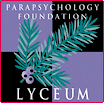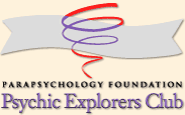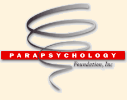 |
 |
| by Thomas Rabeyron University of Edinburgh & Lyon II University Parapsychology seems to be crossing a crucial period whose issue will have an important impact on the future of parapsychology. Thus I would like to propose some ideas concerning the challenges arising from this current situation and underline several possible developments for parapsychology. Parapsychology hasn’t succeeded in becoming, so far, a fully recognized scientific subject. This situation seems notably due to experimental results that are contradictory and whose effects are small and difficult to replicate (Irwin & Watt, 2007). Unfortunately, the difficult quest for a replicable experiment with the ganzfeld has led to statistical arguments (Bem & Honorton, 1994; Milton & Wiseman, 1999; Storm & Ertel, 2001) which hinder the use of this protocol as an easy and efficient way to produce psi effects. Hence, when considering the problem of replication and constancy, parapsychology has not achieved its maturity. The same is true of theoretical formulations. Where several models are trying to explain experimental results, there is no underlying theory to account for several basic questions:
Consequently, without any answer to these theoretical questions, parapsychology only sheds light on an anomaly and its psychological correlates. Furthermore, the field of parapsychology is still limited to only a few researchers and laboratories. The lack of uniformity of approach dilutes the utility of research findings. Hence, parapsychology is still in a difficult situation and encounters the same old problems. The way parapsychologists find new solutions to these challenges will have an important impact on its future evolution. First of all, this situation is probably linked with the following paradox: Parapsychology attracts both ground breaking researchers who are attracted to the complexity of the problems and people simply fascinated by the paranormal. Consequently, there are, on one side, very good researchers, and on the other, amateur investigators whose interpretations and approximations are negative for the image of the whole field. This situation leads to different kinds of undesirable heterogeneity in parapsychology. When considering the interpretation of current data and results, it seems questionable to claim that ESP and PK are scientifically demonstrated. In addition to the fact that actual data are difficult to interpret on existing theoretical grounds (Alcock, Burns, & Freeman, 2003), this claim also has the disadvantage of cutting parapsychology from the mainstream position and therefore from the rest of the scientific community. From my point of view it is more reasonable and relevant to distinguish between facts and interpretations. In the current situation, even if anomalies have been demonstrated, they need to be explored by a range of both skeptical and parapsychological explanations. We should, in the same way, try to explain spontaneous phenomena reported by people. This even-handed approach is probably also an efficient way of avoiding the damaging effects of cognitive dissonance (Festinger, 1957). For the same reason, collaboration with scholarly skeptics is also very important (Schlitz, Wiseman, Watt & Radin, 2006). The current heterogeneity of parapsychology could also be reduced by a standardization of researchers’ competency and qualities, achieved by concentrating research in universities. The efficacy of this approach has been well demonstrated by the legacy of Robert Morris in Great Britain. Will this be encouraged in other countries? It seems to me to be an essential step. Another consequence of this heterogeneity is the absence of a global and consistent research program. Researchers sometimes seem to be more interested in setting up experiments to test their own theories rather than taking into account the relevance of their efforts to the whole field. Because this field is too narrow to allow much variation in protocols, a focus on the main questions should be prioritized. Moreover, the questions tackled by parapsychology are often really complex compared to the small number of researchers who try to solve them. From this point of view, a global plan (as the five year plan which Etzel Cardeña has spoken about at the recent congress in Utrecht) sounds like a favorable step for parapsychology. This standardization of the research should be associated with research whose main objective is the production of knowledge, and not with a subversive parapsychology which mainly questions the foundations of the current scientific knowledge. From this point of view, parapsychology risks being considered as a foreign body by the academic world, even if the questions parapsychology asks are valid. Science needs to rely more on its foundations than on its weaknesses. So, what are the possibilities of knowledge production for parapsychology? First of all, the “Holy Grail” question — the replicable experiment — shouldn’t be forgotten even if some parapsychologists argue that proof-oriented research is no longer necessary. The aim of such proof-oriented research is not only to convince the parapsychological community: This kind of research is necessary for the whole scientific community. Furthermore, where experiments about the sheep-goat effect (Lawrence, 1993) or dream telepathy (Ullman, Krippner, & Vaughan, 1973) seem to have reached a reasonable level of reproducibility, these protocols are too onerous to be set up easily by independent research teams. This is why it seems important to design a replicable but user-friendly experiment. Daryl Bem’s approach (Bem, 2008) is particularly interesting and the development of ready-to-use software appears to be a promising way forward. The study of belief in the paranormal is another field of research that has already produced academic knowledge (Irwin, 1993). This is the same with schizotypy (Goulding, 2005), mental boundaries (Thalbourne, 2000) or altered states of consciousness (Cardeña, Lynn, & Krippner, 2000), which are intimately linked to parapsychology. Research in these domains is beneficial to the whole of psychology, and as marginal experiences, paranormal experiences shed light on human behavior in general. Neuroscience can also be another productive domain (Brugger & Mohr, 2008) and promising results about these experiences could be obtained especially from visual imagery (Alexander, 2002). Counseling for people who have exceptional experiences (Coly & McMahon, 1989), as already developed in Germany at IGPP, seems also promising. The help given to people who report paranormal experiences allows parapsychology to produce knowledge linked with pragmatic applications. A recent congress about clinical parapsychology at Utrecht seems to be a sign that this field of research is expanding too (Kramer, Bauer & Hovelmann, 2009). Last, but not least, could parapsychology become potentially a discipline of excellence? I see at least two reasons why this might happen. The first one relates to methodology. Given the challenges that parapsychology poses to researchers, this field requires both creativity and intellectual rigor. It is not by chance that within universities parapsychologists are generally seen as good methodologists. The second reason concerns the necessary trans-disciplinary involvement in parapsychological research. How many disciplines require understanding and associating concepts from physics, biology and psychology at the same time? Parapsychology could then be an original model in the academic landscape, as it promotes the dialogue between different fields of study. But parapsychology is still hindered by the problem of reproducibility. Is this problem the consequence of 1) the non-existence of ESP and PK (Alcock, 2003); 2) small effect size (Utts, 1991); or 3) a characteristic of psi effects (Lucadou, 1995)? This issue is of course central to the standard view of a scientific discipline and new approaches have been initiated to try to solve it. This may explain why a gap seems to be drawn between the supporter of classical models and those who prefer an alternative model that takes into account the experimental effect. In the latter approach, the Model of Pragmatic Information (Lucadou, 1995) and the Weak Quantum Theory (Atmanspacher, Römer, & Walach, 2002; Lucadou & Romer, 2007) appear to be most promising. Whatever quantum effects account for psi, some correlations between these theories and parapsychological data, at least at a metaphorical level, are heuristic enough to be studied carefully (Radin, 2006). The notions of complex systems and emergent properties at different levels of organizational complexity are particularly interesting and their consequences could be a determinant for science in general. The formulation of psi in all its forms as temporal anomalies, as proposed by Dick Bierman (Bierman, 2008) at the recent PA congress, is also interesting. But it is absolutely vital that these theoretical ideas lead to testable experiments which will confirm or refute new hypotheses; and this will probably not be possible without a global program of research and the standardization to which I have already referred. Finally, it might be necessary to develop new epistemological approaches. If the theories and models referred to in the last paragraph are relevant, the boundary between the researcher and the object of study may need to be redrawn, or if this boundary is more permeable than we actually suppose, these effects are likely to be incompatible with our current epistemological models of science. Hence, if parapsychology cannot find its present recognition in science-proper, maybe other possibilities are needed. From this point of view, it seems that the development of good applications, associated with rigorous, first class research, could be an innovative way of promoting serious investigation of the subject. Indeed, even if there have been in the past applications experiments leading to interesting results — in particular the “Stargate” program (Hyman, 1996; Utts, 1996) —, there are too few reports of solidly evaluated applications. Could we promote further the development of parapsychology applications that would play a social role, such as financial applications, search for missing people or archaeology, all of which have been given sporadic attention in the past? Parapsychology is therefore at a crossroad and several ways forward are possible. By associating pragmatism, rigorousness and creativity, let us hope that at least one of them will lead to an academic stream of research strong enough to establish knowledge about paranormal experiences that is accepted by the wider scientific community. Alcock, J. (2003). Give the null hypothesis a chance. Journal of Consciousness Studies, 10(6-7), 29–50. Alcock, J., Burns, J., & Freeman, A. (2003). Psi wars: Getting to grips with the paranormal. New York: Academic Books. Alexander, C. H. (2002). Psychic phenomena and the brain: An evolution of research, technology, and understanding. Journal of Parapsychology, 66(3), 219–220 [abstract]. Atmanspacher, H., Römer, H., & Walach, H. (2002). Weak quantum theory: Complementarity and entanglement in physics and beyond. Foundations of Physics, 32(3), 379–406. Bem, D. J. (2008, August). Feeling the future III: Additional experimental evidence for apparent retroactive influences on cognition and affect. Paper presented at the 51st Annual Convention of the Parapsychological Association, Winchester, England. Bem, D. J., & Honorton, C. (1994). Does psi exist? Replicable evidence for an anomalous process of information transfer. Psychological Bulletin, 115, 44. Bierman, D. (2008, August). Consciousness induced restoration of time-symmetry (CIRTS): A psychophysical theoretical perspective. Paper presented at the 51st Annual Convention of the Parapsychological Association, Winchester, England. Brugger, P., & Mohr, C. (2008). The paranormal mind: How the study of anomalous experiences and beliefs may inform cognitive neuroscience. Cortex, 44(10), 1291–1298. Cardeña, E., Lynn, S. J., & Krippner, S. (2000). Varieties of anomalous experience: Examining the scientific evidence. Washington: American Psychological Association. Coly, L., & McMahon, J. (1989). (Eds.) Psi and clinical practice. New York: Parapsychology Foundation. Festinger, L. (1957). A Theory of cognitive dissonance. Stanford, CA: Stanford University Press. Goulding, A. (2005). Healthy schizotypy in a population of paranormal believers and experients. Personality and Individual Differences, 38(5), 1069–1083. Hyman, R. (1996). Evaluation of a program on anomalous mental phenomena. Journal of Scientific Exploration, 10(1), 31–58. Irwin, H. (1993). Belief in the paranormal: A review of the empirical literature. Journal of the American Society for Psychical Research, 87(1), 1–39. Irwin, H., & Watt, C. (2007). An Introduction to Parapsychology. Jefferson City, NC: McFarland. Kramer, H. Bauer, E., & Hovelmann, G. (in press). (Eds.) The clinical aspects of exceptional human experiences. Stiching het Johan Borgman Fond. Lawrence, T. R. (1993, August). Gathering in the sheep and goats... A meta-analysis of forced-choice sheep-goat ESP studies, 1947-1993. Paper presented at the 36th Annual Convention of the Parapsychological Association, Toronto, Canada. Lucadou, W. von, Romer, H., & Walach, H. (2007). Synchronistic phenomena as entanglement correlations in generalized quantum theory. Journal of Consciousness Studies, 14(4), 50–74. Lucadou, W. von (1995). The model of pragmatic information (MPI). European Journal of Parapsychology, 11, 58–75. Milton, J., & Wiseman, R. (1999). Does psi exist? Lack of replication of an anomalous process of information transfer. Psychological Bulletin, 125(4), 387–391. Radin, D. (2006). Entangled minds: Extrasensory experiences in a quantum reality. New York: Paraview Pocket Books. Schlitz, M., Wiseman, R., Watt , C., & Radin , D. (2006). Of two minds: Skeptic-proponent collaboration within parapsychology. British Journal of Psychology, 97, 313–322. Storm, L., & Ertel, S. (2001). Does psi exist? Comments on Milton and Wiseman’s (1999) meta-analysis of ganzfeld research. Psychological Bulletin, 127(3), 424–433. Thalbourne, M. (2000). Transliminality: A review. International Journal of Parapsychology, 11(2), 1–34. Ullman, M., Krippner, S., & Vaughan, A. (1973). Dream telepathy. New York: Macmillan. Utts, J. (1991). Replication and meta-analysis in parapsychology. Statistical Science, 6(4), 363–403. Utts, J. (1996). An assessment of the evidence for psychic functioning. Journal of Scientific Exploration, 10(1), 3–30. |
 |

|
 www. parapsychology. org |
||